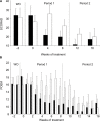Feeding filaggrin: effects of l-histidine supplementation in atopic dermatitis
- PMID: 29042806
- PMCID: PMC5634381
- DOI: 10.2147/CCID.S146760
Feeding filaggrin: effects of l-histidine supplementation in atopic dermatitis
Abstract
Atopic dermatitis (AD), also known as eczema, is one of the most common chronic skin conditions worldwide, affecting up to 16% of children and 10% of adults. It is incurable and has significant psychosocial and economic impacts on the affected individuals. AD etiology has been linked to deficiencies in the skin barrier protein, filaggrin. In mammalian skin, l-histidine is rapidly incorporated into filaggrin. Subsequent filaggrin proteolysis releases l-histidine as an important natural moisturizing factor (NMF). In vitro studies were conducted to investigate the influence of l-histidine on filaggrin processing and barrier function in human skin-equivalent models. Our further aim was to examine the effects of daily oral l-histidine supplementation on disease severity in adult AD patients. We conducted a randomized, double-blind, placebo-controlled, crossover, nutritional supplementation pilot study to explore the effects of oral l-histidine in adult AD patients (n=24). In vitro studies demonstrated that l-histidine significantly increased both filaggrin formation and skin barrier function (P<0.01, respectively). Data from the clinical study indicated that once daily oral l-histidine significantly reduced (P<0.003) AD disease severity by 34% (physician assessment using the SCORingAD tool) and 39% (patient self-assessment using the Patient Oriented Eczema Measure tool) after 4 weeks of treatment. No improvement was noted with the placebo (P>0.32). The clinical effect of oral l-histidine in AD was similar to that of mid-potency topical corticosteroids and combined with its safety profile suggests that it may be a safe, nonsteroidal approach suitable for long-term use in skin conditions that are associated with filaggrin deficits such as AD.
Keywords: amino acid; atopic dermatitis; eczema; filaggrin; l-histidine; nutritional supplement; skin barrier.
Conflict of interest statement
Disclosure CEMG reports grants from Zymogenetics, Stiefel, and Regeneron, grants and personal fees from Novartis and Pfizer. NKG is a founding director of Curapel, a University of Manchester spin-out company owning patents in this field. The other authors report no conflicts of interest in this work.
Figures




References
-
- Williams H, Robertson C, Stewart A, et al. Worldwide variations in the prevalence of symptoms of atopic eczema in the International Study of Asthma and Allergies in Childhood. J Allergy Clin Immunol. 1999;103:125–138. - PubMed
-
- Rönmark EP, Ekerljung L, Lötvall J, et al. Eczema among adults: prevalence, risk factors and relation to airway diseases. Results from a large-scale population survey in Sweden. Br J Dermatol. 2012;166:1301–1308. - PubMed
-
- Weidinger S, Novak N. Atopic dermatitis. Lancet. 2016;387:1109–1122. - PubMed
-
- Katoh N. Future perspectives in the treatment of atopic dermatitis. J Dermatol. 2009;36:367–376. - PubMed
LinkOut - more resources
Full Text Sources
Other Literature Sources

